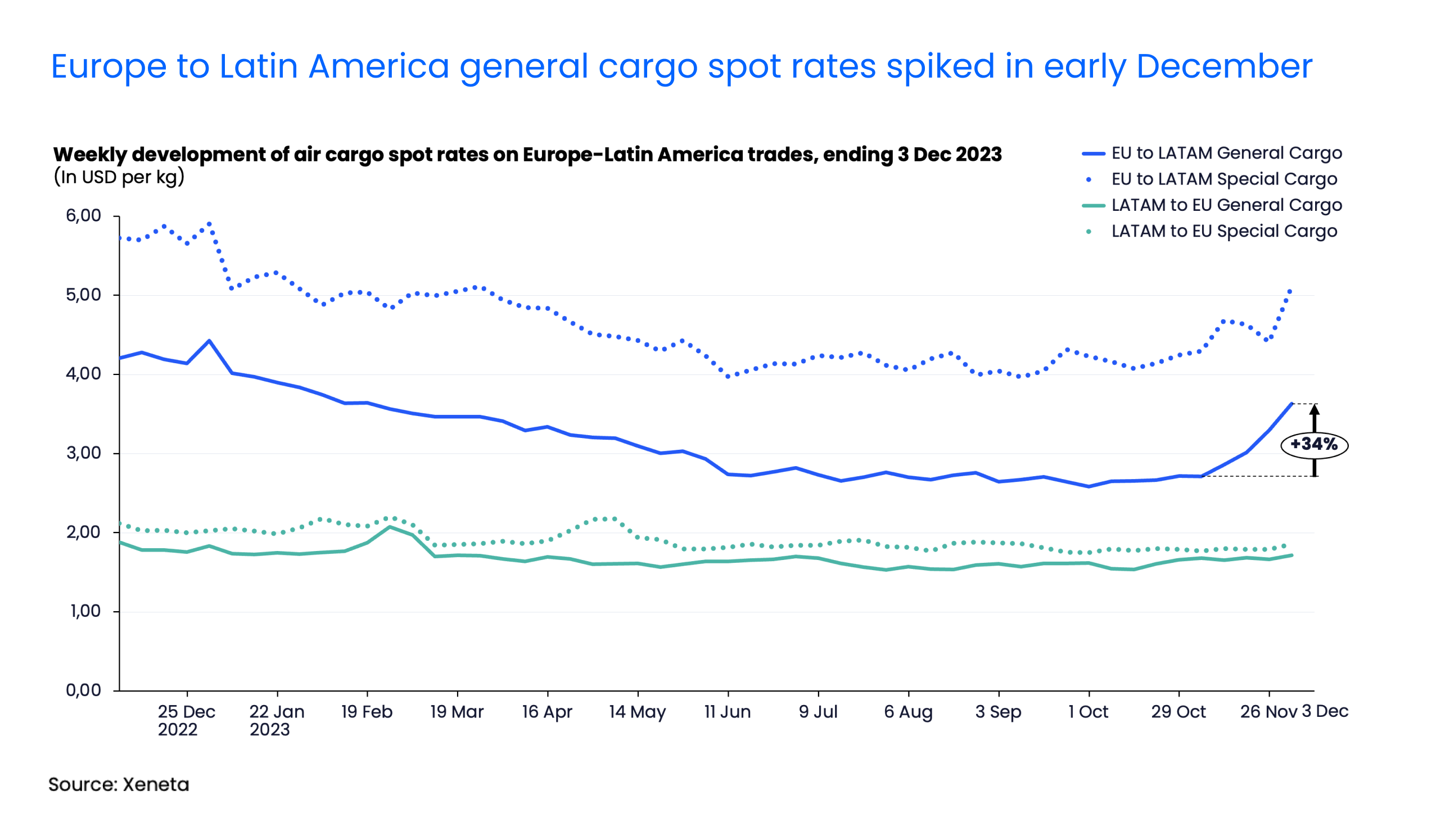As we hurtle towards the end of 2023, how is the air market between Europe and Latin America faring across the front and back hauls where there are differing demands on special and general air cargo.
Europe to Latin America
First, let’s take a look at the fronthaul from Europe to Latin America, where general cargo accounts for around 60% of volumes, with special cargo making up the rest.
Triggered by an increase in special cargo demand, the general cargo spot rate in the week ending 3 December surged 34% from four weeks ago, reaching USD 3.63 per kg.
Behind this average rate lift of 34%, there are numerous stories to tell within the underlying markets.
For example, the market has seen general cargo spot rates from Europe to both Brazil and Mexico increase by 46% and 47% respectively from four weeks ago with rates standing at USD 3.36 per kg and USD 4.39 per kg.
At the other end of the scale, rates to Columbia increased by just 7% in the same period.
Despite this recent upswing in rates, the Europe to Latin America corridor still saw the average general cargo spot rate remain down by 14% compared to the same period last year. The only exception being the Europe to Mexico trade where the general cargo spot rate climbed above the level in the same week in 2022 by +8%.
Turning our attention to special cargo, the spot rate from Europe to Latin America in the week ending 3 December increased by 19% from early November to USD 5.11 per kg.
However, the recent upswing in the spot market has not been spooking the freight forwarders. As the share of cargo volumes that freight forwarders procure on the spot market (the spot share) continue to stay above its pre-pandemic levels. In the week ending 3 December the spot share stood at 49%, up 21 percentage points from the same period in 2019.
Latin America to Europe
Spot rates on the backhaul from Latin America to Europe remained relatively flat during the four weeks ending 3 December.
Special cargo, especially perishables, dominates this backhaul, with general cargo only representing a little over 20% of total market volumes. In the week ending 3 December, the special cargo rate edged up 5% from early November to USD 1.86 per kg.
In the same week, the general cargo spot rate stood at USD 1.71 per kg, up by only 2% from four weeks ago.
When taking a slightly longer view, both special and general cargo spot rates in the week ending 3 December were 12% and 9% below the level at the same time last year.
What comes next?
The corridor from Europe to Latin America will most likely follow the ‘traditional’ seasonal trend, with rates peaking in December before trending downwards in January/February.
This is because cargo demand has remained subdued. Although demand did rise by 8% in the week ending 3 December from early November, it is still down by 9% compared to a year ago.
In the opposite direction, cargo demand on the backhaul from Latin America to Europe is likely to see its second peak period in February when the market is impacted by flower exports for Valentine’s Day.
But it’s not all rosy, because cargo load factor in the week ending 3 December was below the level in the same period in 2019 by 7 percentage points. Ample cargo capacity will therefore continue to add downward pressure on air cargo spot rates from Latin America to Europe.
Want to Learn More?
Watch the latest episode of our monthly State of the Market Webinar for air freight rates to see where you stand in the volatile markets. If you have any questions, please send them to info@xeneta.com.







